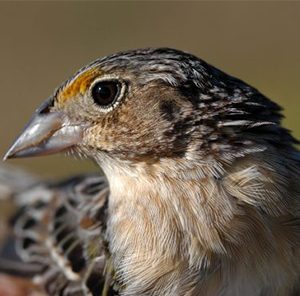Endangered Tiny Bird Has Big Ally in UCF
February 13, 2017

Photo courtesy of Professor Reed F. Noss.
The future of the tiny Florida Grasshopper Sparrow may rest on a hot-water blaster that safely fends off fire ants, which threaten the remaining 100 or so wild sparrows in Central Florida.
Joshua King, a self-described ant nerd, ecologist and entomologist at the University of Central Florida, received $15,500 from the U.S. Fish and Wildlife Federation to use his diesel-powered, hot-water apparatus to blast ant nests that encroach on the endangered sparrows. The federation calls him when they find mounds near sparrow nests. He has published extensively on the life and impacts of fire ants throughout his career.
The endangered sparrow, named after one of their buzz-like calls that is reminiscent of a grasshopper, faces a perfect storm of threats including a lack of habitat thanks to human encroachment, weather extremes like flooding and a decrease in wildfires needed to keep the natural conditions the sparrow needs, King said.
If that isn’t bad enough, Grasshopper Sparrow eggs and fledglings are natural prey for fire ants, one of the state’s most unpopular inhabitants.
The ants are omnivores, meaning they eat both plants and animals, and predators, using their strong jaws and venom-filled stingers to kill their victims before carrying them back to the colony to be devoured.
“Fire ants are a unique and challenging threat to the sparrows,” King said. “Once they detect a hatched, vulnerable sparrow chick they will attack incessantly until the parent birds are overwhelmed and give up trying to pick ants off their chicks. It is a heart-wrenchingly slow form of predation against which the parent birds have little chance to defend their young.”
King and his research team developed a trailer-based system with a tank holding up to 450 gallons of hot water that they take to locations threatened by fire ant infestation.
The apparatus includes the hot-water tank, a pumping system, a diesel motor, and a hose reel and wand. Using the wand to douse an individual ant mound with tens of gallons of near-boiling water is usually enough to put it out of business, King said.
King initially used the system at Fort De Soto Park on the west coast of Florida where his team eliminated nearly all the ant colonies that were a threat to sea turtle nests, also an endangered, protected species. The system could be used to protect other endangered species vulnerable to fire ants.
King said hot water is an ideal deterrent in environmentally sensitive areas. Chemical baits not only pose a health risk for additional wildlife and people, the intended fire ant targets can develop “bait-shyness” over time and stop consuming the insecticides. This reduces the effectiveness of chemical baits over time.
King and his team, including graduate students Leo Ohyama and Phil Shadegg, currently have one complete eradication system that they haul to Osceola County whenever wildlife managers receive reports of new mounds in a sparrow habitat.
Going forward, King and his team hope that the hot-water method will provide a low cost, non-toxic remedy to the fire ant problem for wildlife and land managers throughout the southeastern U.S. and Florida.
Reed Noss, UCF Provost’s Distinguished Research Professor of Biology, estimates the total population of sparrows remaining in the wild as no more than 100 and nearly all of them are in Central Florida. Noss is a former chair of the Florida Grasshopper Sparrow Working Group, which advises state and federal agencies, and has conducted several years of research on the species at Kissimmee Prairie Preserve State Park.
“The Florida Grasshopper Sparrow is one of the most endangered birds in the U.S. and it is in our own backyard,” Noss said. “We can and should be making efforts such as Dr. King’s to preserve them.”
Learn more about King’s innovation, Eco-friendly, Scalable Device Kills and Controls Fire Ants and other Ground-dwelling Insects. To license this technology contact Brion Berman.
Written by: Barbara Abney